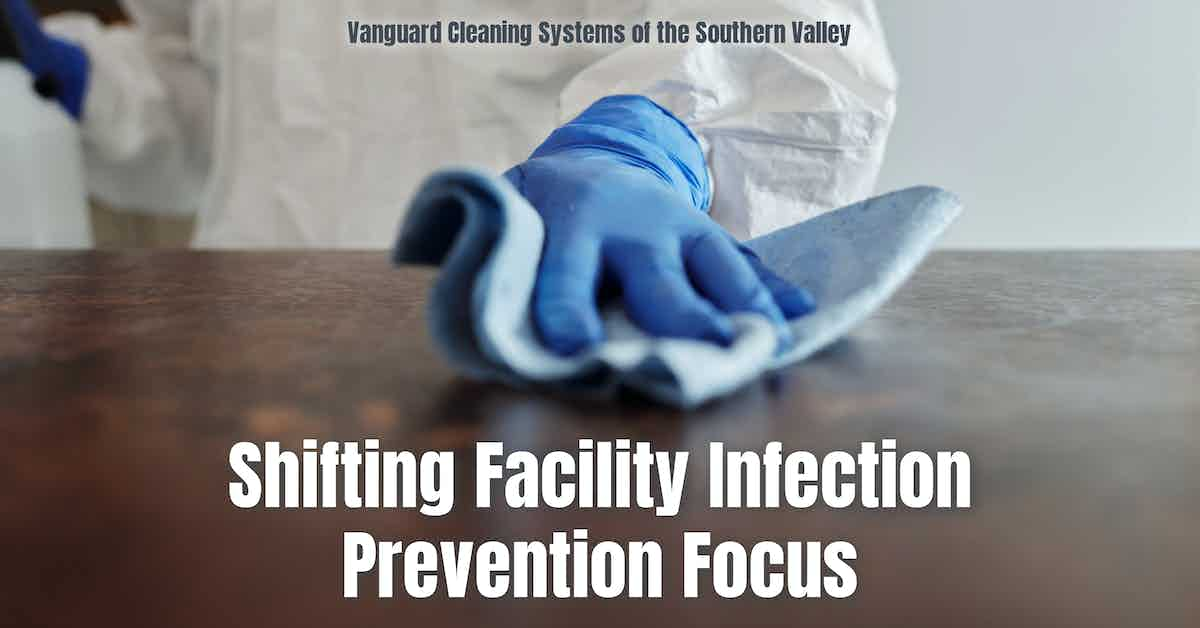Throughout the COVID-19 pandemic, facility infection prevention priorities have shifted from cleaning for appearance, through hygiene theater, to a holistic focus on cleaning for occupant and environmental health.

Post-Pandemic Facility Infection Control Practices
Before the pandemic, custodial professionals pushed for improved cleaning methods to promote occupant health and safety while reducing humanity's environmental impact.
During that pre-pandemic period, many facility hygiene practices outside healthcare environments focused on cleaning for general appearance.
At the height of the pandemic, infection control shifted from panicked widespread, and wasteful disinfection practices to hygiene theater due to a widely disseminated misconception regarding the primary transmission route of SARS-CoV-2.
Per Health.com;
Also called sanitation theater or cleaning theater, hygiene theater is a term used to describe the practice of extreme washing to give off the feeling of improved safety without actually lowering the risk of catching an illness—in this case, COVID-19.
A 2021 science brief from the Centers for Disease Control and Prevention (CDC) explains that the average person's risk of contracting COVID-19 from a surface is less than one in 10,000, or 0.01%.
While the brief says that "it's possible" for people to be infected with COVID-19 from touching an infected surface and then touching their noses, mouths, or eyes, the "risk is generally considered to be low."
The main way people contract the virus is by breathing in infected droplets.
What Is 'Hygiene Theater,' and Can It Hurt, Rather Than Help?
Ultimately, cleaning practices shifted from dangerous and wasteful to targeted and scientifically-driven, with a heavy emphasis on environmental and occupant safety.
Additionally, despite the incalculable damage done to human and environmental health due to over-disinfection, several critical hygiene practices emerged during this period that will positively impact occupant health and the focus of facility infection control measures for years to come, including:
- Hand hygiene.
- Cleaning for health, and;
- Indoor air quality.
Hand Hygiene
Touching a contaminated surface or coming into direct contact with an infected person is a significant route of infectious disease transmission.
The best method for preventing the transmission of pathogens and pathogenic bacteria from humans to surfaces and from surfaces to humans is to adopt a rigorous handwashing practice.
Conventional recommendations typically include lathering your hands with soap and water, scrubbing for a minimum of twenty seconds, rinsing, then drying the hands thoroughly.
Recent history has shown us that:
- Hand hygiene compliance is historically low.
- Compliance can be increased by ensuring easy access to hand hygiene products, like soap, towels, and sanitizer.
- Compliance diminishes in facilities with dirty restrooms and poorly maintained handwashing stations.
Cleaning for Health
Cleaning for health means focusing on long-term human and environmental health, which translates into:
- Using environmentally sustainable products and practices, like microfiber and Safer Choice disinfectants.
- Training service providers on the proper application, handling, and disposal of cleaning and disinfection products and wastewater.
- Using targeted disinfection practices, and;
- Employing ATP and IAQ testing methods to validate cleaning and disinfection practices.
Indoor Air Quality
IAQ has a significant impact on occupant health and performance.
According to the U.S. Environmental Protection Agency;
“Indoor air quality” refers to the quality of the air in a home, school, office, or other building environment. The potential impact of indoor air quality on human health nationally can be noteworthy for several reasons:
Americans, on average, spend approximately 90 percent of their time indoors,1 where the concentrations of some pollutants are often 2 to 5 times higher than typical outdoor concentrations.
People who are often most susceptible to the adverse effects of pollution (e.g., the very young, older adults, people with cardiovascular or respiratory disease) tend to spend even more time indoors.
Indoor concentrations of some pollutants have increased in recent decades due to such factors as energy-efficient building construction (when it lacks sufficient mechanical ventilation to ensure adequate air exchange) and increased use of synthetic building materials, furnishings, personal care products, pesticides, and household cleaners.
IAQ is negatively impacted by:
- Commercial cleaning and disinfection products.
- Outdoor air pollution.
- Pesticides and other chemicals.
- Poor indoor air circulation.
- Volatile organic compounds, and;
- Fungi and mold.
Takeaway
Facility infection prevention practices have shifted from cleaning for appearances, through hygiene theater, to cleaning for long-term sustainable health.
Several critical areas that were ignored until recently--hand hygiene, indoor air quality, and science-based cleaning--have taken the main stage and, based on office worker and consumer demand, are likely here to stay.
Onboarding and managing the requisite labor and material resources will likely prove cost-prohibitive for many organizations.
Outsourcing is a proven method for onboarding highly in-demand cleaning and disinfection services and experience for a fraction of the price of maintaining a similar service in-house.
If you would like more information regarding the effectiveness of high-performance infection prevention and control measures, or if you would like to schedule a free, no-obligation on-site assessment of your facility's custodial needs, contact us today for a free quote!
In Bakersfield, CA, call (661) 437-3253
In Fresno, CA, call (559) 206-1059
In Valencia, CA, or Santa Clarita, CA, call (661) 437-3253
In Palmdale, CA, or Lancaster, CA, call (661) 371-4756

